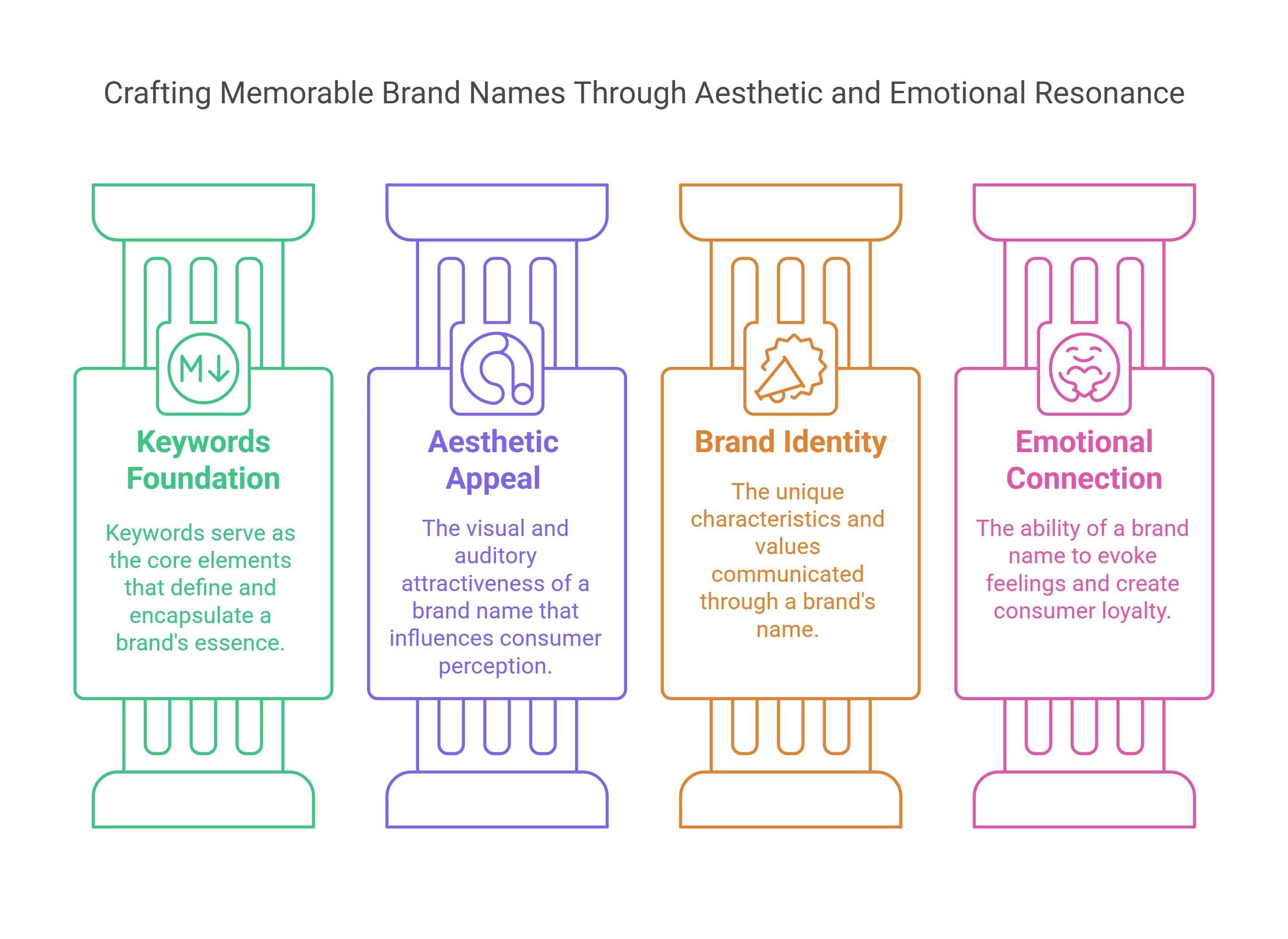Aesthetic Brand Names: Unique & Trendy Ideas for Your Business

Table of Contents
ToggleYour brand name is the first impression—make it unforgettable! Whether you’re launching a chic boutique, a luxury spa, or a modern skincare line, the right name sets the tone for success.
In this guide, we’ve curated a list of unique and trendy aesthetic brand name ideas that exude charm, elegance, and personality. Get ready to find the perfect name that speaks to your brand’s essence and captivates your audience!
Key Takeaways
Know your audience to create a name that speaks to them.
Keep it simple and memorable for better recognition.
Incorporate relevant keywords to boost visibility.
Test your name with potential customers to gather feedback.
Check for trademark issues to avoid legal troubles.
Crafting Aesthetic Brand Names That Resonate
Understanding Your Target Audience
Okay, so you want a brand name that clicks. First things first, who are you trying to reach? Are they Gen Z trendsetters, or are you aiming for a more mature, sophisticated crowd? Knowing your audience is half the battle. Think about what they like, what they dislike, and what kind of language they use.
For example, a brand targeting young adults might use slang or internet-speak, while a brand targeting professionals would stick to more formal language. It’s all about speaking their language, so your brand name feels like it was made just for them.
Incorporating Brand Values
What does your brand stand for? Seriously, what’s the big idea? Is it about sustainability, luxury, innovation, or something else entirely? Your brand name should hint at these values. It’s like a secret handshake that tells people what you’re all about.
Let’s say you’re selling eco-friendly skincare. A name like “Evergreen Glow” instantly tells people you’re all about nature and healthy skin. On the other hand, if you’re selling high-end fashion, a name like “Atelier Luxe” screams sophistication and exclusivity.
Creating Emotional Connections
Names that make you feel something are the ones you remember. Think about brands like “Dove” (peace, purity) or “Nike” (victory, strength). What emotions do you want your brand to evoke? Happiness? Trust? Excitement? A good way to start is by brainstorming words associated with your brand and then playing around with them until you find something that resonates.
Don’t be afraid to get a bit abstract. Sometimes, the most memorable names are the ones that don’t make perfect sense at first glance, but stick with you because of the way they make you feel.
Think of your brand name as the first impression. It needs to be memorable, relevant, and emotionally engaging. It’s not just about what you sell, but how you make people feel.
Exploring Unique Aesthetic Brand Name Ideas
Coming up with the perfect name for your business can feel like a real head-scratcher, right? It’s got to be catchy, memorable, and, most importantly, aesthetic. Let’s have a look at some ideas to get those creative juices flowing. I’ve split them into categories to help you find something that fits your vibe.
Chic and Modern Suggestions
If you’re aiming for a sleek, contemporary feel, these names might just hit the spot. Think clean lines, minimalist design, and a touch of sophistication.
Nova Bloom
Veridian Studio
Aether Craft
Lumi Collective
Timeless Classics
Sometimes, the best approach is to keep it simple and elegant. These names evoke a sense of tradition and understated beauty. They’re the kind of names that will still sound good in ten years.
The Gilded Lily
Rose & Thorne
Willow Creek Designs
Evergreen Atelier
Edgy and Trendy Options
For those who want to stand out from the crowd, these names offer a bold and unconventional twist. They’re perfect if your brand is all about pushing boundaries and embracing the avant-garde.
Neon Riot
Static Bloom
Void Canvas
Echo Collective
Remember, the best name is one that truly reflects your brand’s personality and resonates with your target audience. Don’t be afraid to mix and match elements from these suggestions to create something that’s uniquely yours.
The Importance Of Simplicity In Brand Naming
Memorability and Recognition
Let’s be honest, nobody wants a brand name they can’t remember or struggle to spell. Simplicity is key here. A shorter, easier name sticks in people’s minds.
Think about it: how many long, complicated brand names can you recall off the top of your head? Probably not many. A memorable name is a recognisable name, and that’s what builds brand awareness.
Avoiding Complexity
Complex names can be a real headache. They’re harder to market, tougher to trademark, and often get butchered in conversation. Plus, in today’s world of quick searches and social media tags, a complicated name is just asking for trouble. Keep it simple, and you’ll save yourself a lot of hassle down the line.
The Power of Short Names
Short names are punchy, impactful, and easy to share. They work well on logos, websites, and social media. They also tend to be more available as domain names, which is a huge bonus. A short name can say a lot with very little, and that’s a powerful thing in branding.
A concise brand name isn’t just about aesthetics; it’s about functionality. It’s about making your brand easy to find, easy to remember, and easy to share. In a crowded marketplace, simplicity can be your greatest asset.
Incorporating Keywords For Aesthetic Appeal

Relevance to Your Niche
Okay, so you’re trying to come up with a brand name that’s both cool and actually useful, right? It’s not just about picking something that sounds nice; it needs to tell people what you’re all about.
Think of it like this: if you’re selling minimalist furniture, you wouldn’t want a name that screams ‘shabby chic’. It’s about finding that sweet spot where your brand name hints at what you do without being too obvious.
Consider what makes your brand unique.
Brainstorm words related to your products or services.
Check what your competitors are doing (and then do something different!).
Enhancing Searchability
Let’s be real, if people can’t find you online, it’s like you don’t even exist. That’s where searchability comes in. It’s not enough to have a cool name; you need to make sure people can actually Google it and find you. This means thinking about keywords – those words people type into search engines when they’re looking for something like what you offer.
Use keyword research tools to find relevant terms.
Incorporate keywords naturally into your brand name (if possible).
Check if your chosen name is easy to spell and pronounce.
Balancing Creativity and Clarity
It’s a tricky balance, isn’t it? You want a name that’s creative and memorable, but also clear enough that people instantly get what you’re about. You don’t want to end up with a name that’s so out-there that nobody understands it.
The goal is to find a name that’s both unique and functional. Think of it as a first impression – you want to grab people’s attention, but you also want to make sure they know what they’re getting into.
Here’s a simple table to illustrate the balance:
Feature | Creativity | Clarity |
|---|---|---|
Goal | Stand out from the crowd | Be easily understood |
Risk | Being too abstract or confusing | Being generic or forgettable |
Key Question | Does it spark interest? | Does it communicate what we do? |
Testing Your Aesthetic Brand Name
So, you’ve got a list of potential names that you think are pretty good. Now what? It’s time to put them to the test. You might be head-over-heels for a particular name, but it’s important to get some outside opinions before you commit.
After all, you want a name that not only sounds good to you but also resonates with your target audience and avoids any potential legal issues. Let’s look at some ways to test your aesthetic brand name.
Gathering Feedback from Peers
One of the easiest ways to get initial feedback is to ask your friends, family, and colleagues what they think. Don’t just ask if they like the name; ask them what the name makes them think of. Do they associate it with the kind of aesthetic you’re going for? Is it easy to remember? Do they think it sounds professional?
It’s important to get a range of opinions, so try to ask people from different backgrounds and age groups. Be prepared to hear some criticism – not everyone will love your ideas, and that’s okay! The goal is to gather as much information as possible so you can make an informed decision.
Conducting Market Research
For more in-depth feedback, consider conducting some market research. This could involve surveys, focus groups, or even just informal conversations with potential customers. The key is to get feedback from people who are actually likely to use your products or services.
Here are a few things you might want to ask:
What is your initial impression of the name?
What kind of products or services do you associate with this name?
How memorable is the name?
Would you be likely to recommend this brand to a friend?
Market research doesn’t have to be expensive or time-consuming. Even a small survey can provide valuable insights into how your target audience perceives your brand name.
Checking Domain Availability
This is a practical step, but it’s absolutely essential. You might have the perfect name, but if the domain name is already taken, you could be in trouble. Check to see if the .com, .co.uk, and other relevant domain extensions are available. Also, check social media platforms to see if the name is available on those channels as well. Having a consistent brand name across all platforms will make it easier for customers to find you.
If your preferred domain name is taken, you could try a variation of the name, or you could consider purchasing the domain from the current owner. However, be aware that this can be expensive.
Legal Considerations For Aesthetic Brand Names
Trademark Registration
So, you’ve got this amazing name, right? Before you get too attached, you need to check if you can actually trademark it. Trademark registration gives you the exclusive right to use your brand name and logo for your specific services. It stops others from using something similar that could confuse your clients.
Have a look at the Intellectual Property Office website; it’s got loads of info on how to apply and what’s involved. It might seem like a faff, but it’s worth it for peace of mind.
Avoiding Copyright Issues
Copyright is another thing to keep in mind. You can’t just pinch someone else’s name or slogan and use it as your own. That’s a big no-no. Do your homework and make sure your chosen name is original.
A quick search online can usually flag up any potential problems. If you’re using any images or content on your website, double-check you have the right to use them too. It’s all about being fair and playing by the rules.
Understanding Naming Regulations
There might be specific rules about what you can and can’t call your business, depending on what you do and where you’re based. For example, if you’re offering medical treatments, there might be restrictions on using words that imply you’re a hospital if you’re not.
Check with your local council or relevant professional bodies to make sure you’re not breaking any rules. It’s better to be safe than sorry, and it’ll save you a headache later on.
It’s always a good idea to get some legal advice before you launch your brand. A solicitor who specialises in intellectual property can help you navigate the legal minefield and make sure you’re covered. They can also help you with things like drafting terms and conditions for your website and making sure you’re compliant with data protection laws.
Evolving Your Brand Name Over Time
Brand names aren’t set in stone. What works today might not be the best fit in a few years. Consumer tastes change, your business might expand into new areas, or maybe your original name just isn’t quite right anymore. It’s okay to think about changing it.
Recognising When Change Is Needed
So, how do you know when it’s time to consider a change? There are a few telltale signs. Maybe your brand name is constantly misspelt, or it doesn’t translate well if you’re expanding internationally. Perhaps your business has shifted focus, and the old name no longer reflects what you do. Keep an eye on customer feedback and market trends. If your name feels outdated or irrelevant, it might be time for a refresh.
Maintaining Brand Consistency
If you decide to change your name, it’s important to do it carefully. You don’t want to confuse your existing customers or lose the brand recognition you’ve already built.
Here’s a few things to consider:
Keep some element of the old brand in the new one, if possible.
Communicate the change clearly to your customers.
Update all your marketing materials, website, and social media profiles.
A gradual transition can help ease the change and maintain customer loyalty. Think about keeping the old logo for a while, or using a tagline that explains the new name.
Conclusion
Picking the right name for your aesthetic business is a big deal. It’s not just about sounding good; it’s about making a connection with your clients. A unique, trendy name can capture your brand’s essence, resonate with your audience, and create a strong identity that stands the test of time.
So, take your time with this. Think about what makes your services unique and how you want to be seen in the market. Don’t hesitate to brainstorm, ask for feedback, and even try out a few options before settling on the one that feels just right. Remember, your brand name is the first impression you’ll make, so make it count!
Frequently Asked Questions
What is an aesthetic brand name?
An aesthetic brand name is a name that looks good and sounds appealing. It helps to create a strong identity for your business and attracts customers.
How do I choose a unique brand name?
To choose a unique brand name, think about what makes your business special. Use words that reflect your style and values. You can also combine words or create new ones!
Why is simplicity important in a brand name?
Simplicity is key because it makes your name easy to remember. A simple name can help customers find you quickly and makes it easier for them to talk about your brand.
Can I use keywords in my brand name?
Yes! Using keywords related to your business can help people understand what you do. It can also help with online searches, making it easier for customers to find you.
How can I test my brand name before launching?
You can test your brand name by asking friends and family for their opinions. You can also conduct surveys or check how the name fits with your target audience.
What should I consider when changing my brand name?
When changing your brand name, think about how it will affect your current customers. Make sure the new name still fits your brand’s identity and values.









